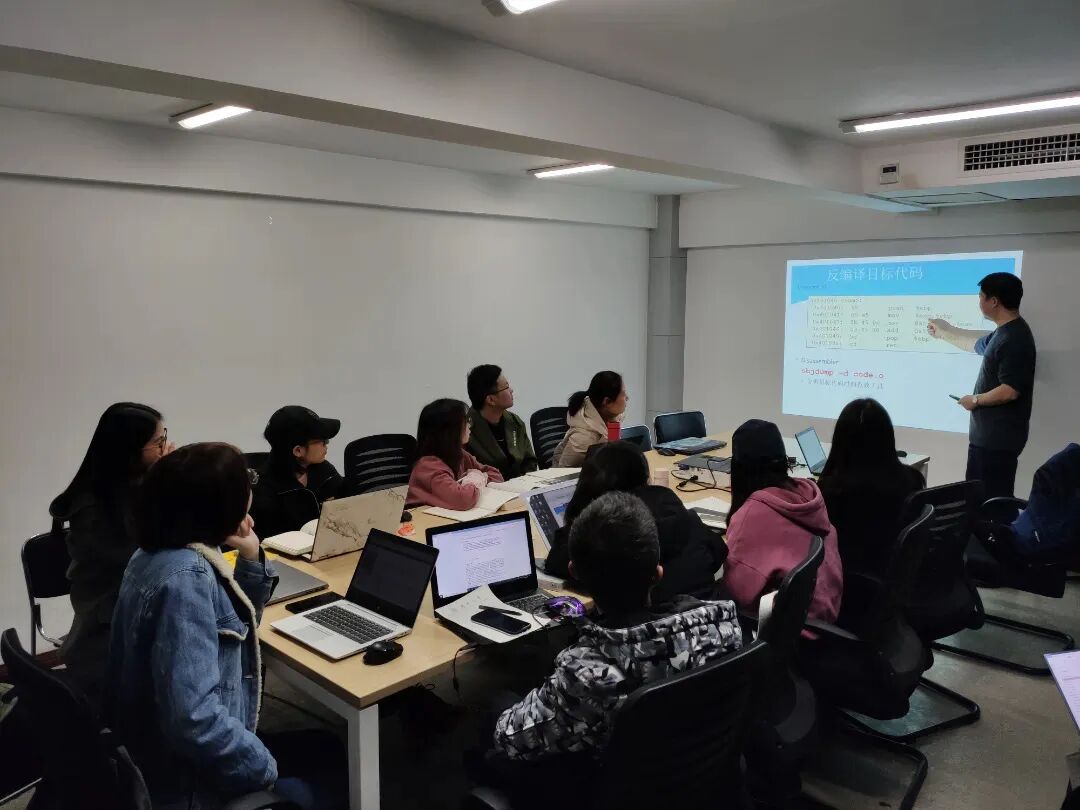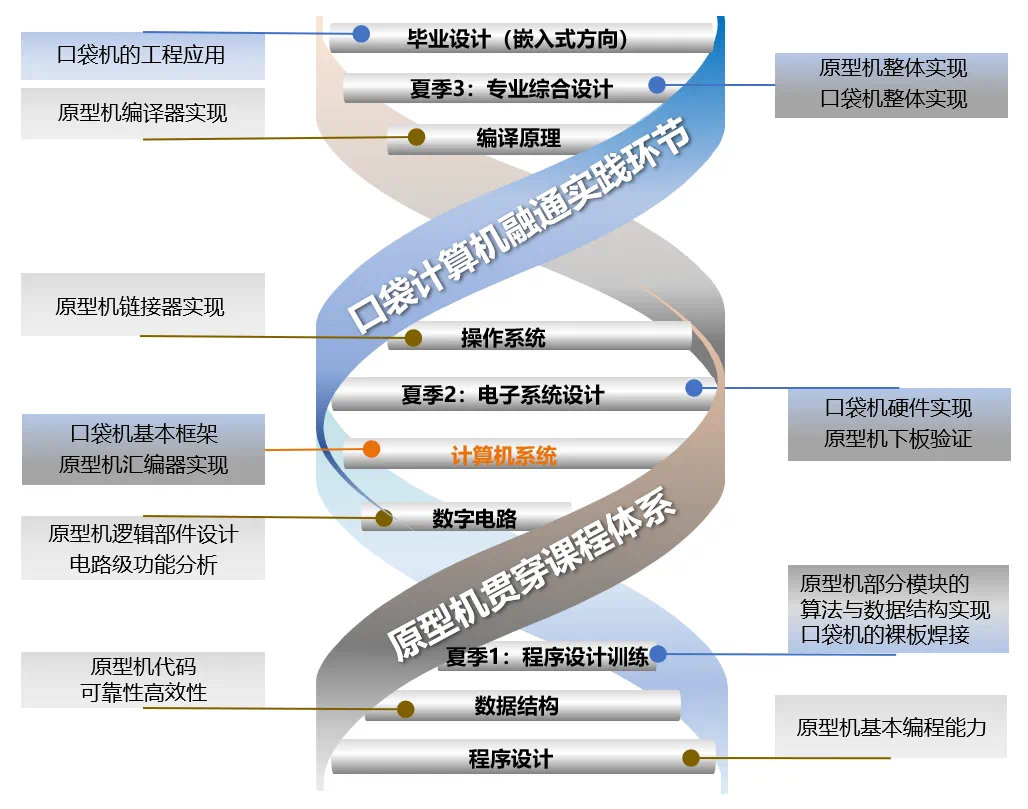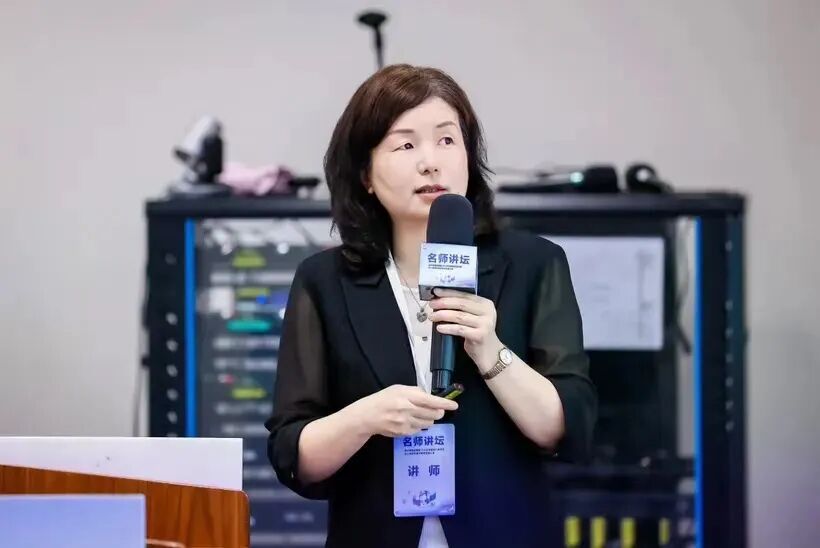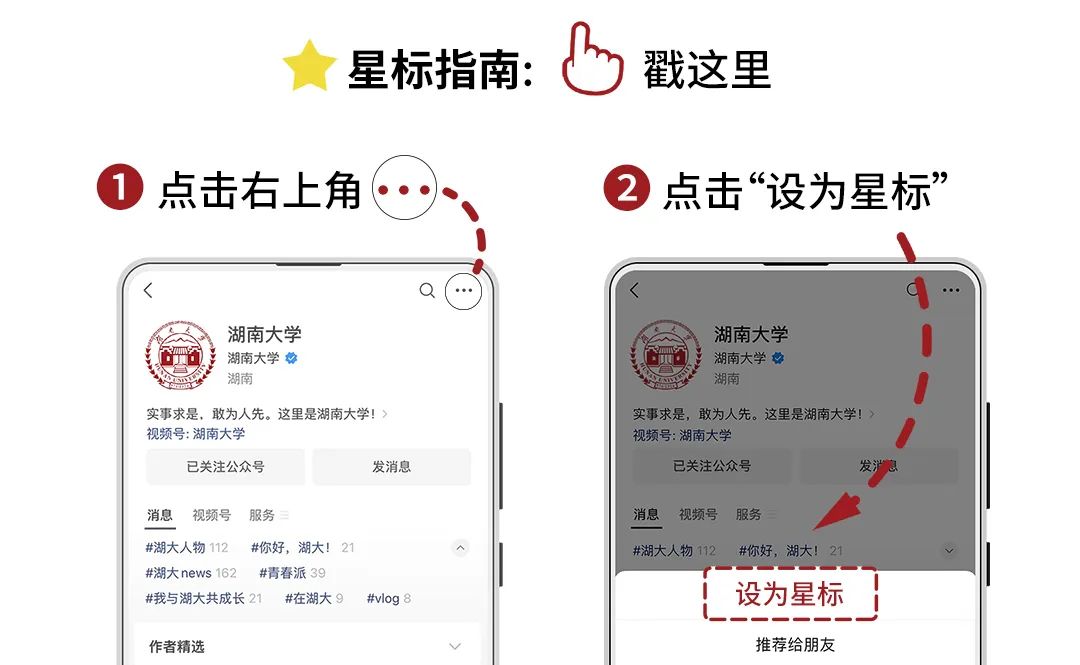
A “Pocket Cat” and Two Prototypes
Ten Years of Deep Engagement and Dedicated Research
This group of teachers at Hunan University, passionate about teaching
Has developed a “dual-loop” curriculum system
Combining theory and practice, from simple to complex
They have customized a system capability training program for students
Integrating industry and education, covering the full stack
They cultivate more competitive computer professionals
01Ten Years of Accumulation, the “Teamwork” of the Curriculum Group
“I will refer back to CPU design related content using pipeline CPUs.”
“In my class, the implementation of pipeline CPUs can serve as a discussion topic for students to explore in depth.”
“This can also be used as a teaching case to help students understand that a good compiler must be optimized in conjunction with hardware.”
……
Gathered around a conference table, several teachers spontaneously engaged in a lively discussion, which is a daily routine for the core curriculum teaching team of the School of Information Science and Engineering at Hunan University—almost every month, Professor Zhao Huan organizes a seminar for the core curriculum teaching team of the computer science major.

Professor Zhao Huan organizing a teaching seminar.
From the “individual efforts” of a single course to the “teamwork” of the curriculum group, the teaching team has spent a full ten years.
In 2015, Professors Zhao Huan, Yang Kehua, Liu Yan, and Huang Lida undertook the teaching reform task for the computer systems course using the textbook “Computer Systems: A Programmer’s Perspective” from Carnegie Mellon University. The teaching team integrated the CPU design part of computer systems into the preceding digital circuits course and required students to independently design a CPU with 16 instructions. However, the initial reform brought about problems.
“During my class, I heard many students complain that the previous course was too difficult. We observed that many students did not understand the execution behavior of instructions at the circuit level and how control signals are generated in each clock cycle—these are concepts that should have been mastered in the digital circuits course, indicating that they still lacked a framework for understanding the entire system’s operation.” In this situation, the teaching team decided to redesign the top-level structure from the perspective of the curriculum group.

Teaching assistant training.
Professor Zhao Huan led the team to reconstruct the core curriculum system of digital circuits, computer systems, operating systems, and compiler principles, connecting all courses based on students’ cognitive learning patterns. A self-created simple prototype VSPM (12 instructions) runs through the digital circuits and computer systems courses, while another self-created prototype RSPM (40 instructions) and the miniCC compiler connect the computer systems course to the operating systems and compiler principles.
In terms of faculty arrangement, attention is also paid to continuity; for example, Teacher Liu Yan participates in the teaching of the preceding digital circuits course, adjusting teaching content and pace in a timely manner; Teacher Yang Kehua connects with subsequent courses such as operating systems and compiler principles, gathering needs during the teaching process to solidify the foundation for students in advance.
The teaching team independently developed a virtual computer prototype and a mini compiler, extracting the framework code from millions of lines of code to simplify the learning difficulty for students, making it easier for them to understand the entire system’s operation framework; at the same time, through the physical computer “Pocket Cat,” students can practice hands-on, transforming theoretical knowledge into practical applications. This system not only consolidates the learning of preceding courses but also addresses the confusion left by the fragmented learning of individual courses, achieving two goals at once, allowing knowledge to be interconnected and enabling students to gradually establish a complete framework of computer systems, possessing full-stack development and optimization capabilities.
02Connecting the Dots, Customizing an Integrated Teaching System
“We cannot be satisfied with training programmers who can only write code; we must cultivate more architects and engineers with full-stack development capabilities; we cannot be satisfied with training technology followers; we must cultivate world leaders in technology,” Professor Zhao Huan stated, explaining that the teaching team insists on conducting collective lesson preparation once a month, discussing problems encountered during teaching and solutions, gradually forming the concept of the “dual-loop” teaching system.
By dividing the four years of students’ coursework into a system, they construct a horizontal capability chain of “program design → system design → system engineering → professional quality,” and a vertical course chain supporting capability cultivation through “basic courses → advanced courses → concentrated practice → outcome assessment.”
The foundation of this curriculum system is the prototype and “Pocket Cat” developed by the teaching team. Students build the “Pocket Cat” themselves; the college uniformly purchases bare boards and components such as resistors and capacitors, which students complete soldering during the summer of their freshman year; in the summer of their sophomore year, based on what they learned in digital circuits and computer systems courses, students implement the prototype’s code and download it to the basic board for subsequent expansion; in the summer of their junior year, students expand interfaces and external devices on the basic board based on their respective majors, developing applications such as IoT; during the senior design phase, students can continue in-depth research and development based on this platform.
The prototype and “Pocket Cat,” one virtual and one physical, one software and one hardware, jointly construct a spiral iterative, progressively advancing teaching system of “curriculum integration + practical integration,” closely linking theoretical teaching with practical components, achieving teaching goals that are gradual, from simple to complex, and step-by-step, comprehensively enhancing students’ practical and innovative abilities.

Based on the “Prototype + Pocket Cat” dual spiral iteration of “curriculum integration + practical integration.”
Under this system, Wang Wei from the IoT Engineering Class 2201 has greatly benefited. The computer systems learning in his sophomore year allowed him to gradually build systematic capabilities. “The ‘Pocket Cat’ left a deep impression on me; when I first went to the training center to solder circuits, many classmates didn’t understand how this related to coding and system writing, but in my sophomore year, when my self-written CPU ran on the ‘Pocket Cat’ to manage and control other hardware, it was an enlightening experience, and I understood the concept of hardware-software collaboration in computer systems.” In the 2024 National IoT Competition, Wang Wei and his team completed hardware selection and software design in just two months, winning first prize and securing provincial venture capital support for their project, leading to company registration in March 2025.
03Curriculum System Promoted, Collaborating with Huawei for Innovation
Now, this curriculum system has established a model course group with demonstrative effects, achieving a series of important results.
The project won the second prize of the National Teaching Achievement Award in Higher Education in 2022, and the “Kunpeng Computer System Capability Training Course Group Virtual Teaching and Research Office” was selected by the Ministry of Education as one of the first pilot projects for virtual teaching and research offices. The computer systems course was recognized as one of the first national-level first-class undergraduate courses, and the “Prototype + Pocket Cat” teaching system was successfully included in the “101 Plan” practical platform.
In just two months, the computer systems and comprehensive practice courses published on the Touge practice teaching platform attracted over ten thousand learners, with online experiments conducted over 70,000 times, and were adopted by more than 50 universities.
This curriculum system has not only been recognized by universities but has also benefited from collaborations with enterprises. To better integrate Kunpeng technology into university teaching systems, in 2023, various product lines from Huawei proactively approached Hunan University for collaboration, jointly developing the Kunpeng Pro development board aimed at computer systems teaching and native development, and initiating the construction of a computer systems capability course group based on the Kunpeng ecosystem. Currently, the first phase of the collaboration has been recommended on the homepage of the Huawei Kunpeng community for nationwide promotion.
In January of this year, Professor Zhao Huan and Associate Professor Yang Kehua launched a live broadcast themed “Introduction to the Integrated Practical Teaching System of Core Computer Courses,” which attracted over ten thousand viewers in just three hours; in March and April, the team focused on “Practical Teaching of Core Computer Courses Based on the Orange Pi Kunpeng Pro Development Board” and conducted multiple offline training activities at Huawei…

Professor Zhao Huan sharing teaching insights.
From solid course group construction to innovative integrated teaching, from teaching reform in higher education to cross-border collaboration with enterprises, this team at Hunan University’s School of Information Science is passionately driving the teaching reform of core computer courses, striving to cultivate innovative talents with “system capabilities” in computer science.

Source丨Media Center, School of Information Science and Engineering
Reporter丨Peng Jingyi Yu Chuqian
Photography丨Ren Junhao
Editor丨Luo Lidan
Chief Editor丨Yu Chuqian
Recommended Reading



Reprint with source: Hunan University (ID: HNU1926)

